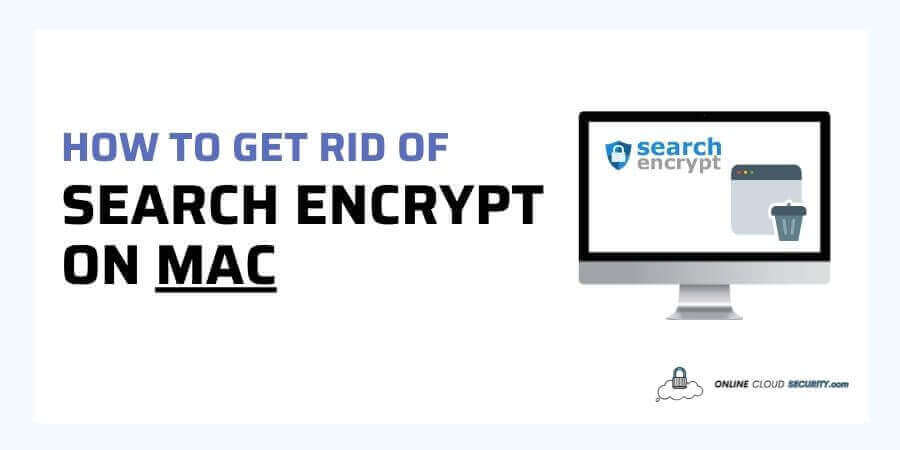
Dave Miller – Tech Enthusiast & Security Expert – May 25th, 2022

Not a fan of any other search engine and wondering how to remove Search Encrypt from your Mac? Search Encrypt is a potentially unwanted program (PUP) often included in download packages but provides no utility to consumers. Yes, you should delete PUPs from your device to prevent these potentially unwanted apps from posing a serious threat to your devices.
Removing a PUP may involve additional procedures if you don’t have protection. Still, PUPs, like other malicious software, are pretty straightforward to prevent if you understand how they sneak onto your computer. There are various options to do so, fortunately.
Continue reading the article to learn why it gets classified as a PUP and why you should remove it and other PUP software.
The Search Encrypt explains itself as an add-on to protect your privacy by identifying searchers that might get traced and linked to your personal information. The sponsored adverts on their search engine results page provide the company with all of its revenue. Many other internet security firms, on the other hand, disagree with their viewpoint. They classify Search Encrypt as a browser hijacker PUP and recommend permanently removing it.
It is because a browser hijacker gets considered malicious software that alters the behavior, settings, or look of a browser without the user’s permission. It will compel you to utilize them by changing your browser’s homepage and search engine. It may also generate advertising money or make damaging actions like data collecting and keystroke monitoring easier.
The issue is that not all of the malware security you already have will identify PUPs software. It is primarily because you provided permission for it to get installed, even if unintentionally. As a result, you must be selective when selecting a solution to assist you in guarding against Search Encrypt and other related PUPs.
To delete it altogether, you must first learn the appropriate approach for how to remove Search Encrypt from your Mac
Below are the methods for how to remove Search Encrypt from your Mac; you can choose either one of these that sounds straightforward to you
The most straightforward way to get rid of Search Encrypt is to use a third-party malware remover, which in this case is Malwarebytes. Because the Malwarebytes research team already labeled Search Encrypt as a browser hijacker, it is much easier to remove. So follow the below steps for using Malwarebytes for how to remove Search Encrypt from your Mac
Note: If Malwarebytes Premium had already installed on your devices, It would have notified you before the software installed itself, allowing you to stop it.
SpyHunter for Mac is a powerful malware detection engine that analyzes your Mac for malicious threats. It may also safeguard your computer from adware, trojans, viruses, and other infections. Additionally, it has a built-in system optimizer that cleans out unneeded and residual data from your hard drives. Now, if you feel Search Encrypt has attacked your machine. In such a case, you may remove it with Spyhunter by following the instructions below.
Note: Remember that the Spyhunter Free Remover only enables you one remediation and removal for results identified after a 48-hour waiting period.
Note: You can put any discovered object in the Exclusions section to prevent it from showing in future scan results.
CleanMyMac X is a one-stop solution created just for your Mac. It has capabilities that remove megatons of garbage from your computer and make it perform quicker. Furthermore, CleanMyMac X features an integrated tool for uninstalling extensions, making Search Encrypt removal straightforward. Follow the below steps for how to remove Search Encrypt from your Mac
Note: You may download CleanMyMac X for free before purchasing it from their shop.
Another third-party software optimizer that can help you optimize and clean up your Mac is PowerMyMac. It allows you to free up Mac storage capacity, help accelerate your MacBook with a few easy clicks, and preserve your Mac in the best possible condition. Additionally, it cleans out your browsing history and removes extensions from all your browsers. follow the steps below
Note: You may do the same thing with the other browsers.
To manually remove the PUP extension, you will have to go through each of your browsers infected with the Search Encrypt malware.
Note: First, delete the software that brought Search Encrypt into your computer in the first place. You may remove it by following Apple’s published instructions.>>
You may also restore your browser to default settings to remove all extensions by going through the guide below
But if you simply want to uninstall Search Encrypt only instead of resetting all browsers, follow the steps below for the browser you use
Safari is the best browser to access the internet on all your Apple devices. It’s also the default browser on Mac, so you’ll probably use it instead of others. Even if it’s from Apple, keep in mind that it’s still vulnerable to viruses. So, if you previously removed Search Encrypt from your Mac using the Apple official guide for the program removal. You may remove it from your browser by following the steps below.
It will erase your Safari cache and preferences and uninstall the Search Encrypt.
With a market share of 69.28 %, Google’s cross-platform web browser is the most popular. If a person isn’t using Safari, they’re almost certainly using Chrome. If your Chrome browser has got infected, follow the procedures below.
It will restore Chrome to its standard settings, wiping off any saved data and removing Search Encrypt.
One of the options for Mac users is Firefox, which has 7.48 % of the web browser market share. Follow the instructions below to uninstall Search Encrypt.
Note: You can also find the official guide form Search Encrypt to remove the extension here: Official Guide
Sophos’ Hitman Pro malware removal application checks your computer for trojans, keyloggers, worms, spyware, and Search Encrypt and helps you remove them quickly. Although it is a paid service, it also provides a free 30-day trial that does not need credit card information. As a result, you may use it to remove any potentially malicious browser extensions by following the instructions below.
When installing valid software, a download prompt may display, requesting that users read the terms and conditions before downloading. So, what did you overlook? Because you accepted the terms and conditions without reading them, PUPs (potentially unwanted applications) included with freeware get installed. You may also be unaware that this has occurred since detecting a PUP can be difficult because they get commonly disguised, but it is critical to know-how.
Fact: Only 1% of technology users read the terms and conditions, according to ProPrivacy.com.
PUPs’ intentions are frequently blurred since their creators want you to think they’re beneficial, so you’ll keep them installed. They get not classified as malware. The primary distinction is that you consent to the PUP download, even if you are unaware. It can lead to the user device being targeted and exploited.
PUPs get intended to make removing them from the host computer difficult. As a result, I’ve provided numerous methods. However, as previously stated, these programs fall into a middle area from being labeled as malware. Their classification may vary depending on the study team that examines the software. To avoid them in the future, keep the following suggestions in mind.
Search Encrypt gets frequently packed with various free programs. It got most likely installed since you were not paying attention while installing any other legitimate software. Furthermore, The Search Encrypt malware might have a detrimental influence on your online experience. As previously said, Search Encrypt makes money via advertisements. Clicking any ad might lead you to dangerous websites or start downloading harmful malware on your Mac.
Since Search Encrypt and other similar viruses may also infiltrate your system. It is best to remove them, regardless of how much these PUPs promise to bring additional benefits. It may save you a lot of headaches.
While deleting this extension isn’t problematic, it does need a few steps. Fortunately, there are programs available to assist you in removing any undesirable or harmful PUPs, and I’ve also highlighted manual techniques. It is up to you to choose which strategy is most effective for you.
**Onlinecloudsecurity.com is a participant in the Amazon Services LLC Associates Program, an affiliate advertising program designed to provide a way for websites to earn advertising revenues by advertising and linking to Amazon.com and affiliated sites. As an Amazon Associate we earn affiliate commissions from qualifying purchases.**

Dave Miller is an IT Consultant for Online Cloud Security and has over 7 years of experience in the Information Technology space. He also specializes in repairing laptops & computers. In his spare time, he loves to talk about new technologies and hosts monthly IT and Cyber Security meetings in the Houston area.
Click any button down below to share this article on the following channels:

Online Cloud Security is here to recommend you the most secure devices, from laptops to smartphones, we only want to provide you with products that we have tested and used ourselves for online security. Every product that we recommend is heavily inspected and tested for security against hackers, viruses, malware, and any other intruders that may want to steal your information.

Online Cloud Security is here to recommend you the most secure devices, from laptops to smartphones, we only want to provide you with products that we have tested and used ourselves for online security. Every product that we recommend is heavily inspected and tested for security against hackers, viruses, malware, and any other intruders that may want to steal your information.
Your Trusted Source for Online Security